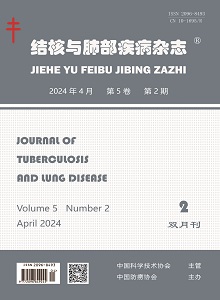Objective: To investigate Internet of Things (IoT) combined with multi-disciplinary diagnosis, treatment (MDT) and rehabilitation nursing model for recovery of chronic obstructive pulmonary disease (COPD). Methods: From May to December 2019,a prospective study was conducted in 83 COPD patients who were diagnosed and hospitalized in Hebei Chest Hospital (control group); and 83 COPD patients diagnosed and hospitalized from June to November 2020 were included as observation group. The control group received conventional lung rehabilitation nursing measures, and the observation group received IoT combined with MDT rehabilitation nursing mode for lung rehabilitation management on the basis of conventional nursing. Blood gas analysis indexes, lung function indexes, anxiety score, depression score, Barthel score, health knowledge score, length of stay and nursing satisfaction at discharge were compared between the two groups at admission and 6 months after discharge follow-up. Results: The length of hospitalization in the observation group was significantly shorter than that in the control group ((10.28±2.44) d vs. (19.67±1.27) d; t=6.054, P=0.011). Nursing satisfaction at discharge was similar between the two groups (59.04% (49/83) vs. 53.01% (44/83), χ2=3.254, P=0.434). Six months after discharge, oxygen partial pressure ((9.41±0.11) kPa), forced expiratory volume in the first second (1.90 (1.72, 2.21) L), FEV1/FVC ((66.86±4.52) %), maximum expiratory flow (3.95 (3.70, 4.02) L/s) and Barthel score (73.59±10.49) in the observation group were significantly higher than those in the control group ((8.84±0.32) kPa, 1.43 (1.17, 1.62) L, (61.74±3.59) %, 3.27 (2.85, 3.64) L/s, 68.73±12.37), the differences were statistically significant (t=12.235, P=0.032; U=-7.654, P=0.000; t=-8.081, P=0.000; U=15.327, P=0.003; t=2.730, P=0.007), the PaCO2 ((5.13±0.57) kPa), anxiety score (10.28±2.13) and depression score (10.27±0.44) of the observation group were significantly lower than those of the control group ((5.64±0.81) kPa, 19.45±5.11, and 16.27±2.11, respectively), the differences were statistically significant (t=11.251, P=0.041; t=15.090, P=0.000; t=25.361, P=0.000). Conclusion: For COPD patients, developing standardized pulmonary rehabilitation strategy for recovery intervention through combining IoT with MDT rehabilitation nursing mode, could significantly improve emotion, quality of life, the symptoms of dyspnea, reduce the impact of the disease on patients, and shorten the length of hospital stay.

 Wechat
Wechat